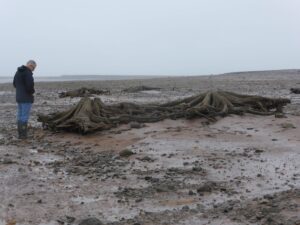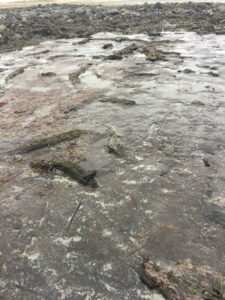

We are slowly becoming accustomed to the idea that the world experienced by our ancestors was very different to our own, even within the span of a few millennia. Nowhere is that made clearer than when standing among the remains of a long-dead forest, especially when it lies in a landscape devoid of trees.
Many of the clues to the landscape and environment of the past are well hidden and require specialist equipment and skills to reveal and interpret them. The species and significance of a pollen grain, for example, or the patterning of mineral deposition within a soil core. These are things that would pass me by, did I not have colleagues enthusiastic enough to study them and patient enough to take the time to make sure that I understand them. But, to trip over a tree stump from the past – now, that is a different matter altogether.
One of the best places to experience preserved ancient forests is in the intertidal zone. But it is an appreciation that I have only gained in recent years. As a child, I guess I was focused on the sandcastle and rockpool potential of a beach; as a young adult, I saw them as places of beauty – good for a long walk and exercise. Now, my fascination has shifted again. I’ve been lucky enough to experience the forests of the sea in a few places now and they never cease to amaze me.
Others came to this understanding long before I. In 1913 a little book entitled Submerged Forests was published by Clement Reid, a geologist who had been collecting information as part of his work on British harbours. It is a brilliant exposition of material from around the shore. Reid appreciated that the tree remains he saw indicated that the UK had once been very different and his book includes the first published reconstruction of Doggerland, the conjoining of Britain to the continent. But Reid was not the first. Nineteenth century publications include the work of Watt and Traill Dennison in Orkney, and as far back as the twelfth century a chronicler named Gerald of Wales was commenting on the discovery of submerged tree trunks.
Nevertheless, my own journey to enlightenment has been fun. And it is an ongoing process. I do not think I will ever lose my sense of wonder at wandering among the remains of trees that were last experienced as living beings by the archaeological communities I study. Occasionally they are truly spectacular, in 2018 I was privileged to visit the submerged forests of the Minas Basin, far out in the intertidal zone at Grand Pre, in Nova Scotia. The trunks here were truly spectacular and lay a considerable distance from the shore. It was, in the original sense of the word, awesome. At home in Orkney the trunks are considerably smaller than that, but fascinating nonetheless. In the Western Isles of Scotland, the tree remains, though also smaller, bear surprising contrast to the treeless aspect of the current landscape. I’ve not visited the much-photographed trees at Borth in Wales, but they are on my wish list, and there are many others.
Of course, in some places submerged forests are associated with archaeological remains such as stone tools and this is very exciting, but, for now, I want to focus on the trees themselves. On what they mean. All bear witness to a time when relative sea-level was lower so that the landmasses of our ancestors were bigger, and trees and woodland were more common, indicators of vegetation and climatic differences to today. Past worlds were different. Of course, where they have been dated, the periods at which these woodlands flourished vary. Some date back as much as six thousand years or more, while others are more recent, a mere three or four thousand years old. We are so used to approaching the past as somewhat sterile, that the opportunity the trees provide to experience the tangible nature of the ancient world around us is, for me, an emotional one. It really brings home the type, and extent, of change that has taken place.
If you have not tried it, I would encourage you to go down to the woods today. There are opportunities around the world. All you need is a good pair of wellies. And it is good for the soul.
You must be logged in to post a comment.